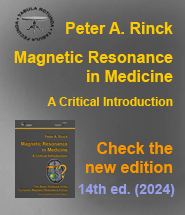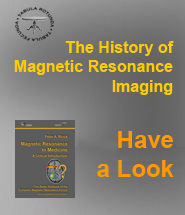Glosario
| a | b | c | d | e | f | g | h | i | j | k | l | m | n | o | p | q | r | s | t | u | v | w | x | y | z |
M
Mxy → Transverse magnetization.
Mz → Longitudinal magnetization.
M0: equilibrium value of the magnetization; directed along the direction of the static magnetic field. Proportional to spin density, rho, ρ or N.
Macroscopic magnetic moment: → Macroscopic magnetization vector.
Macroscopic magnetization vector: net magnetic moment per unit volume (a vector quantity) of a sample in a given region, considered as the integrated effect of all the individual microscopic nuclear magnetic moments. Most NMR experiments actually deal with this.
Magnetic dipole: north and south magnetic poles separated by a finite distance. An electric current loop, including the effective current of a spinning nucleon or nucleus, can create an equivalent dipole.
Magnetic field (H): the region surrounding a magnet (or current carrying conductor) is endowed with certain properties. One is that a small magnet in such a region experiences a torque that tends to align it in a given direction. Magnetic field is a vector quantity; the direction of the field is defined as the direction that the north pole of the small magnet points when in equilibrium. A magnetic field produces a magnetizing force on a body within it. Formally, the forces experienced by moving charged particles, current carrying wires, and small magnets in the vicinity of a magnet are due to magnetic induction (B), which includes the effect of magnetization, while the magnetic field (H) is defined so as not to include magnetization. However, both B and H are often loosely used to denote magnetic fields. For definition of field strength see Chapter 3.
Magnetic field gradient → Gradient magnetic field.
Magnetic induction (B): also called 'magnetic flux density'. The net magnetic effect from an externally applied magnetic field and the resulting magnetization. B is proportional to H, with the SI unit being the Tesla (T).
Magnetic moment: a measure of the net magnetic properties of an object or particle. A nucleus with an intrinsic spin will have an associated magnetic dipole moment, so that it will interact with a magnetic field (as if it were a tiny bar magnet).
Magnetic resonance → Nuclear magnetic resonance (NMR). Another magnetic resonance phenomenon is electron spin resonance (ESR).
Magnetic resonance imaging: earlier also: NMR imaging, magnetic resonance imaging, commonly used term: MR imaging, MRI (→ zeugmatography). Creation of images of objects such as the human body by use of the nuclear magnetic resonance phenomenon usually by the application of magnetic field gradients. The immediate practical application involves imaging the distribution of hydrogen nuclei (protons) in the body. The image contrast in a given region is usually dependent jointly on the spin density and the relaxation times, with their relative importance determined by the particular imaging technique employed. Contrast is also affected by motion such as blood flow.
Magnetic susceptibility (χ): measure of the ability of a substance to become magnetized.
Magnetization: the magnetic polarization of a material produced by a magnetic field (magnetic moment per unit volume); (→ Macroscopic magnetization vector).
Magnetogyric ratio → Gyromagnetic ratio.
Magnitude: also 'absolute value' or 'modulus'; referring to the signal intensity of an MR image which can be proportional to the amplitude of the transverse magnetization which is a non-negative number.
MAST → Motion compensation.
Matrix image matrix; grid of columns and rows, for instance 256×256, with a total number of 64,536 pixels.
Maxwell coil a particular kind of gradient coil, commonly used to create gradient magnetic fields along the direction of the main magnetic field.
Megahertz (MHz): unit of frequency, equal to one million Hertz.
Meiboom-Gill sequence → Carr-Purcell-Meiboom-Gill sequence.
MHz → Megahertz.
Modulus → Magnitude.
Motion compensation: modifying the field gradients used in a pulse sequence such that flow and acceleration do not induce any additional phase effects.
MRA: Magnetic Resonance Angiography.
MRI: Magnetic Resonance Imaging.
MRM: Magnetic Resonance Mammography.
MRR: Magnetic Resonance Relaxometry.
MRS: Magnetic Resonance Spectroscopy.
MRSI: Magnetic Resonance Spectroscopic Imaging.
Multiple line-scan imaging (MLSI): variation of sequential line imaging techniques that can be used if selective excitation methods which do not affect adjacent lines are employed. Adjacent lines are imaged while waiting for relaxation of the first line toward equilibrium, which may result in decreased imaging time. A different type of MLSI uses simultaneous excitation of two or more lines with different phase encoding followed by suitable decoding. This can be extended to planar sequences.
Multiple slice imaging: variation of sequential plane imaging techniques that can be used with selective excitation techniques that do not affect adjacent planes. Adjacent planes are imaged while waiting for relaxation of the first plane toward equilibrium, resulting in decreased imaging time.
Multiple sensitive point: sequential line imaging technique utilizing two orthogonal oscillating magnetic field gradients, an SSFP pulse sequence, and signal averaging to isolate the sensitivity to a desired line in the body.
Missing terms? Send us an e-mail. We'll add them ...












